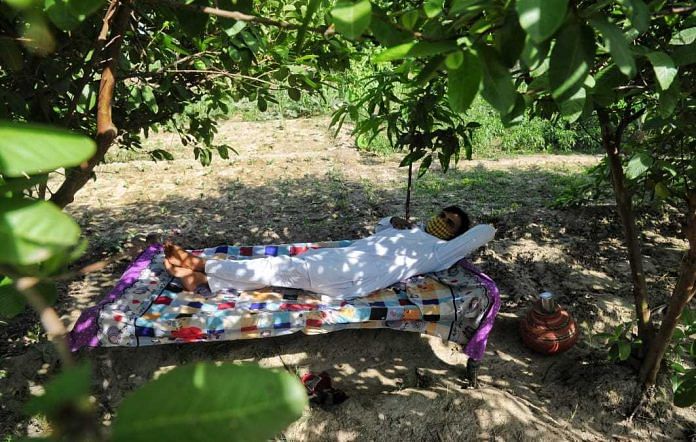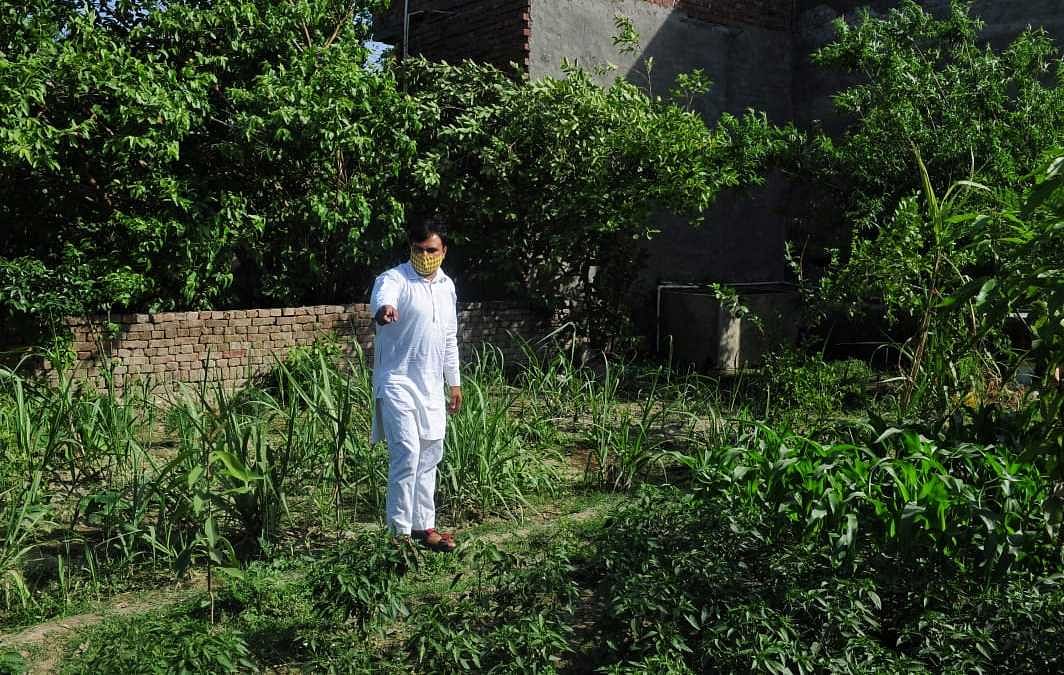
Naangla Aar (Panipat): When Pradeep Rathi, a 31-year-old farmer who tested positive for Covid-19, had difficulty breathing, he tried to get medical help but to no avail.
So he lay down under a grove of guava trees on his farm in Nangla Aar village, eight kilometres from Panipat, and recovered. Or that’s what he claims.
Rathi said after he suffered shortness of breath, he thought he was going to die. “So if I were to die, it better be on my farm.”
“These trees have fed me and kept me alive since I was born. So when I felt I was about to die, I said I’ll die on my farm … I took a cot and went and lay down under them. And see, they treated me so well. Nature heals. I instantly felt better,” Rathi said. “I’ve read that trees are the lungs of the world, the source of oxygen.”
For seven days starting 6 May, Rathi would just lie on his stomach and walk around his farm. People from the village would keep him company but from a distance.
No oximeter or oxygen cylinder
Rathi says he had to put his faith in guava trees because he had no other choice. Experts, however, have a word of caution: sitting under the trees doesn’t help restore oxygen levels.
Rathi started experiencing symptoms of Covid-19 on 30 April, so he isolated himself and started living in his shop in front of the house. He tested positive for Covid on 3 May and had trouble breathing for the first time on 6 May, which is when he resorted to sitting under trees during the day. He would retire to his shop at night.
He tried getting an oximeter to check his oxygen saturation level but didn’t find any. He also tried to procure an oxygen cylinder, but nothing was available.
He then spoke to the village’s ASHA worker and got Vitamin C, Zinc, and paracetamol tablets. “My heartbeat was so fast that the entire bed would throb because of the vibrations. My phone would jump up and down and my bed would shake. But there are no facilities here. No doctor nearby, so I said if I’ve to die I’ll die here in my farm, not at some hospital,” Rathi said.
He says he also approached the nearest Primary Health Centre, 6 kilometres away in Khodpura, but couldn’t get a thermometer or oximeter. They only sent medicines, he said. However, the PHC called him regularly to check on him.
The ASHA worker said: “I’ve asked them (the PHC) to give me thermometers, oximeters, and a mask for myself but I haven’t received anything. I only get a 7-day regimen of these tablets to give to patients if they have symptoms or test positive,” she said.

Reluctance to visit hospitals
Rathi was reluctant to visit a hospital because many in his village believed that once admitted, Covid-positive patients never return.
The villagers here swear by herbal concoctions. “I took my medicines alright but it’s herbal medicines that cleared my lungs, I’ll tell you that,” Rathi said.
Lack of beds in hospitals also made Rathi rely on trees. Panipat was among the worst affected districts in Haryana during the second wave. Between 5-11 May, its positivity rate had reached 48.3 per cent, the highest in the state.
Rathi says when the district was witnessing a surge in Covid cases, hospital authorities weren’t handing over Covid bodies. “One couldn’t even see the face of the dead family member or bring their body home. This is also why I didn’t want to go to the hospital,” he told ThePrint.
As of 26 May, Panipat had 49 ventilator beds, 150 ICU beds, and 687 oxygen beds across 30 government and private hospitals in the district, according to data provided by SDM Swapnil Patil. The district has a population of 12.05 lakh according to the 2011 census.
On 4 May, when Rathi’s symptoms worsened, there were 5,525 active patients in Panipat, according to the state health bulletin.
‘Trees won’t magically restore oxygen levels’
Dr Preeti Kumar, vice president, health support systems at the Public Health Foundation of India, however, said sitting under trees doesn’t help. “The concentration of oxygen isn’t high when you’re under a tree. So it won’t magically restore your oxygen levels,” she said.
However, proning, good nutrition and hydration along with fresh air do help a patient recuperate. “Patients with hypoxia, that is, where the oxygen saturation remains above 85 per cent, mostly recover. Especially with the help of proning, which this gentleman did. As long as the body doesn’t enter a cytokine storm, which means the body’s own immune system doesn’t start attacking the patient, the patient remains stable,” she said.
Rathi, meanwhile, says as a farmer he works very closely with nature. And he couldn’t have approached anyone better to save his life.
Subscribe to our channels on YouTube & Telegram
Why news media is in crisis & How you can fix it
India needs free, fair, non-hyphenated and questioning journalism even more as it faces multiple crises.
But the news media is in a crisis of its own. There have been brutal layoffs and pay-cuts. The best of journalism is shrinking, yielding to crude prime-time spectacle.
ThePrint has the finest young reporters, columnists and editors working for it. Sustaining journalism of this quality needs smart and thinking people like you to pay for it. Whether you live in India or overseas, you can do it here.